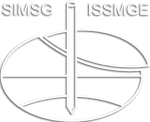Chemical compatibility of sand-bentonite backfills amended with biopolymer in vertical barriers
Chemical compatibility of sand-bentonite backfills amended with biopolymer in vertical barriers
This study presents the chemical compatibility and microscopic properties of unamended sand-bentonite (SB) backfill and xanthan gum (XG)-amended SB (XG-SB) backfill, for use in vertical barriers to control lateral movement of lead contaminated groundwater. Liquid limit and hydraulic conductivity tests were carried out on the unamended and XG-amended backfills to assess their chemical compatibility when exposed to lead nitrate (Pb(NO3)2) solutions. The findings of this study present that XG-amendment greatly enhanced the liquid limit of unamended backfill. The hydraulic conductivity (k) of unamended and XG-amended backfills increased as the concentrations of lead solutions increased. The k of XG-amended backfill was found to be less than the acceptable threshold (i.e, 10-9 m/s), whereas that of unamended backfill was higher than 10-9 m/s when exposure to lead solutions. Scanning electron microscope (SEM) images presented that polymer hydrogels (i.e., XG hydrogels) blocked the intergranular pores of backfill and the sand particles were covered by hydrated bentonite and XG hydrogel, which results in narrower and more tortuous flow paths that were responsible for low k of XG-amended backfills as compared to unamended backfills. An extensive comparison of k for unamended and polymer-amended SB backfills on the basis of this study and previous studies showed that type and content of bentonite, polymer amendment, and cation concentration of testing liquid greatly affected the hydraulic performance of the SB backfills.
Xian-Lei Fu; Yan-Jun Du; S. Q. Shen; N. J. Jiang; Y. L. Yang
9th International Congress on Environmental Geotechnics (ICEG2023)
Engineered Barriers
Geoenvironmental Engineering
https://doi.org/10.53243/ICEG2023-93
